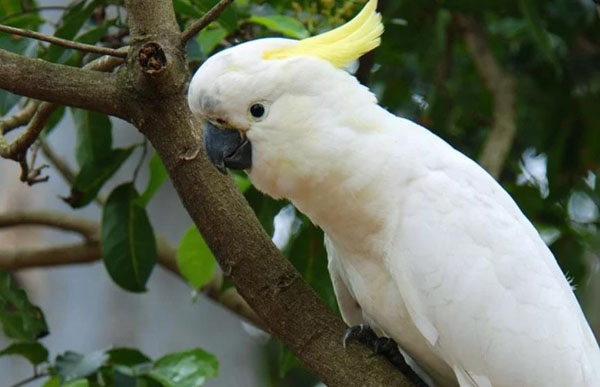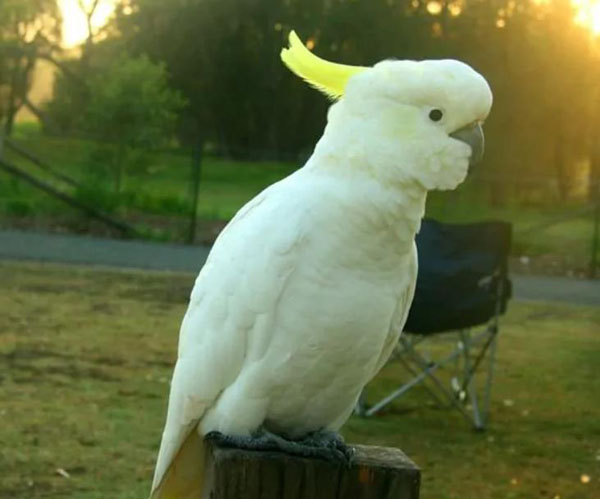Sulphur-crested Cockatoo
IUCN
LCBasic Information
Scientific classification
- name:Sulphur-crested Cockatoo
- Scientific Name:Small Budan, Large Sunflower Cockatoo, Large Sunflower Cockatoo, Sunflower Budan
- Outline:Climbing birds
- Family:Psittaciformes C.family C.genus
Vital signs
- length:40-50cm
- Weight:815-975g
- lifetime:80years
Feature
It is characterized by a thick and strong bill, powerful beak, and average language ability.
Distribution and Habitat
Distributed in the north, east and south of Australia, Tasmania, Kangaroo Island, East Moluccas, New Guinea, King Island, Aru Island, etc. in Indonesia, and also introduced to some non-native places such as New Zealand and several islands.
In Australia, Sulphur-crested Cockatoos live in forests, woodlands and farmland, while in New Guinea, they live in lowlands and forests at an altitude of 1,400 meters. They often live in forests or forest edges, sometimes like to go to rural farmland to forage for crops, and occasionally can be seen in parks or green spaces.
Appearance
The body feathers are mainly white. There are yellow crest feathers on the top of the head. When disturbed by the outside world, the crest feathers stand up in a fan shape and can reach 14 cm long, like a blooming sunflower. The male and female sunflower cockatoos are the same color, and the gender cannot be distinguished by the feather color. The iris of male birds is black, and that of female birds is brown.
The upper beak is connected to the skull like a hinge and can move freely. There is a wax film at the base of the beak, and the tongue is fleshy and soft with a horny spoon-shaped tip. The wings are slightly pointed, the legs are short and strong, and there are four toes on the feet, two toes in front and two in the back, which is called the anti-dactyl type. The claws are sharp and curved, suitable for climbing trees.
Details
Like many cockatoos, the Sulphur-crested Cockatoo requires a lot of time as a pet. Its feathers are non-iridescent, mainly white, with a lot of feather powder, and it needs to be bathed regularly. It has a noisy voice and will raise its crest when angry. Its food includes seeds, shells, berries, nuts, fruits, sprouts, flowers, insects, etc. Its language ability is average.

Sulphur-crested cockatoos usually live in groups, often in groups of hundreds. When foraging, they will disperse into small groups. They usually forage on the ground. Some will be on guard in the trees to pay attention to whether there is any danger. When there is a dangerous situation, they will warn their foraging companions. When flying, they often make loud and hoarse calls. Sometimes they forage in crop areas, causing serious agricultural losses. They are regarded as pests. Farmers in some areas are allowed to hunt sulphur-crested cockatoos that damage crops. Some people also hunt them for their beautiful feathers.
In the wild, the nests are built in the holes of tall trees during the breeding period. The breeding period in southern Australia is from August to January, and in the north it is from May to September. In New Guinea, there are traces of activities from the lowlands to the forests at an altitude of 1,400 meters. There are about 2-3 eggs in a nest, usually 2 eggs, and the incubation period is 25 to 27 days. The chicks stay in the nest for 9 to 12 weeks.

In captivity, they will become noticeably quieter during the breeding period. The nest boxes provided should be equipped with solid metal edges. Metal nest boxes can be used or hung outside the cage. Otherwise, the strong bite force will seriously damage the wooden nest boxes, and even completely destroy or damage the bottom in a short period of time, endangering the safety of eggs and chicks. During the breeding period, male sulphur-crested cockatoos often become very aggressive towards female birds, often chasing female birds and even attacking them. Therefore, nest boxes with two holes (T-shaped or upright) can be used, so that female birds are less likely to be forced into a dead end and seriously injured during the chase. Female birds lay about 2 to 3 eggs at a time, and the incubation period is about 30 days. After 9 to 10 weeks, feathers grow. Sometimes they will be sensitive and uneasy when the nest box is checked. Adult birds are able to reproduce after 4 or 5 years old.
This species is very large in number locally, so it is not close to the threshold range standard under vulnerable. Despite this, the overall population is declining. The scale of the decline has not been quantified, but it is not below the vulnerable population size. For these reasons, it is rated as Least Endangered.








